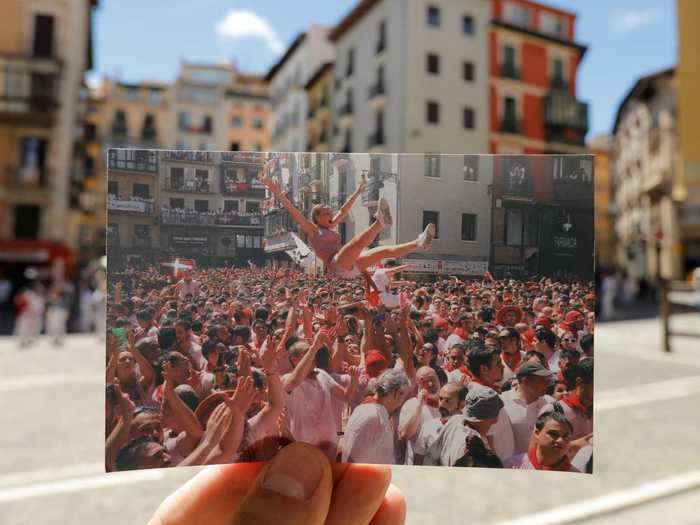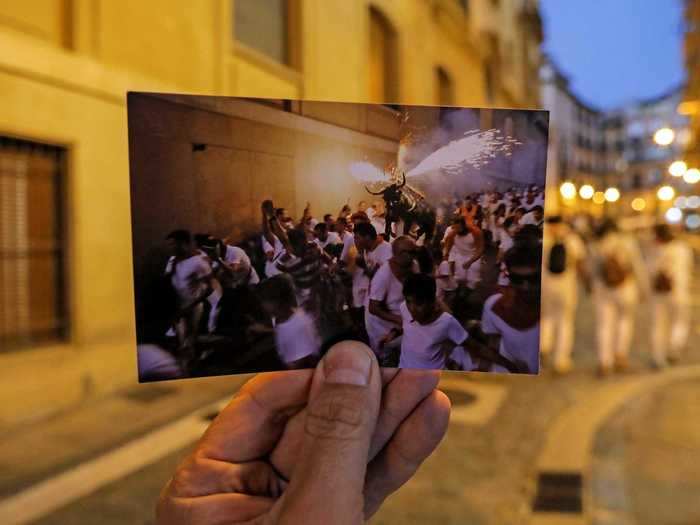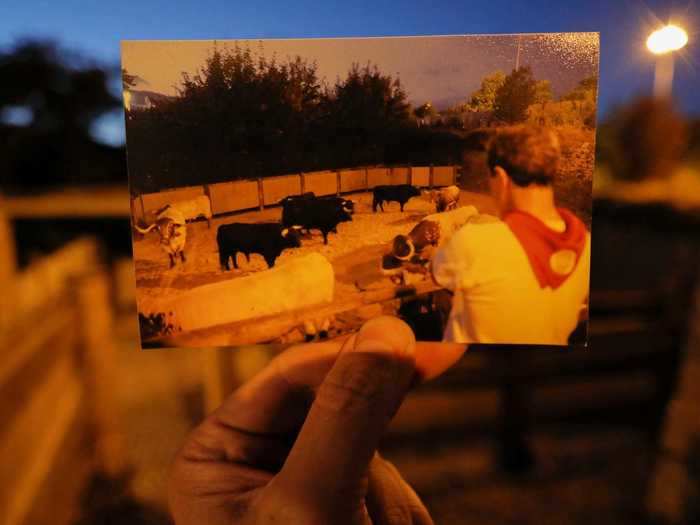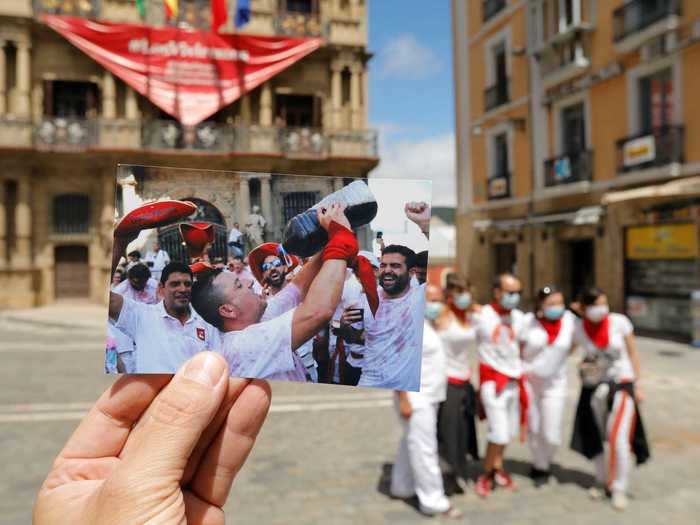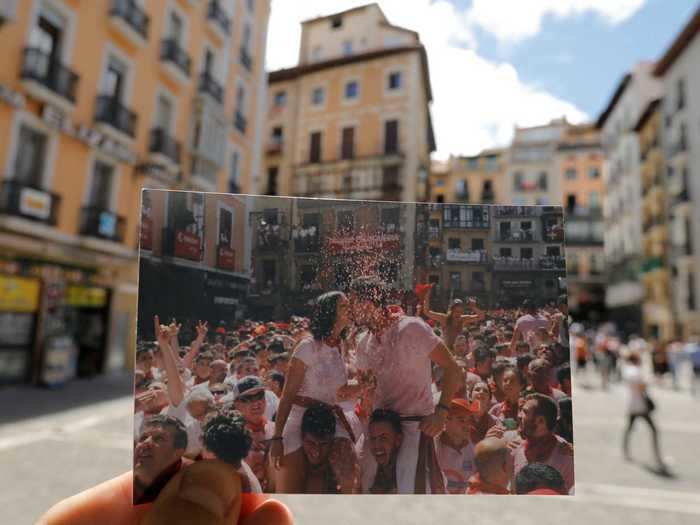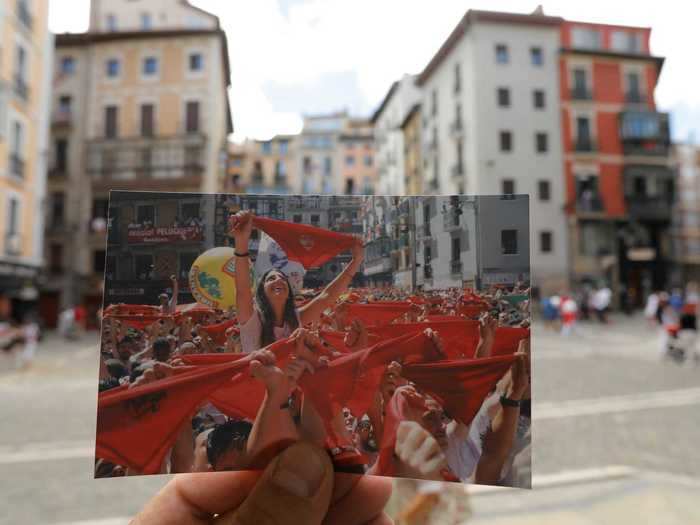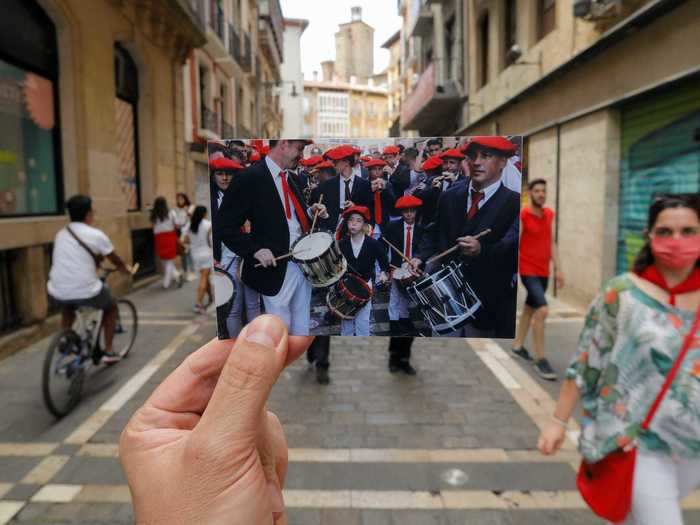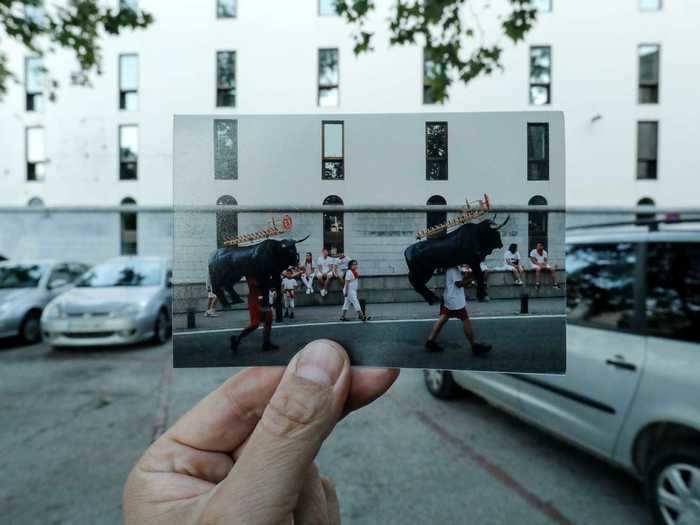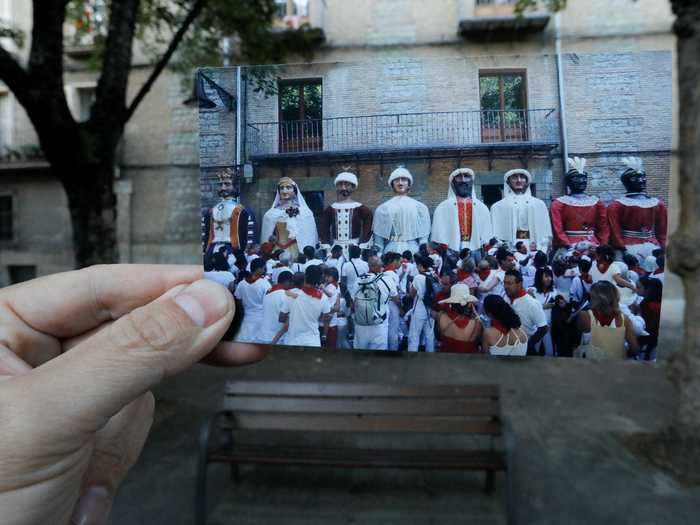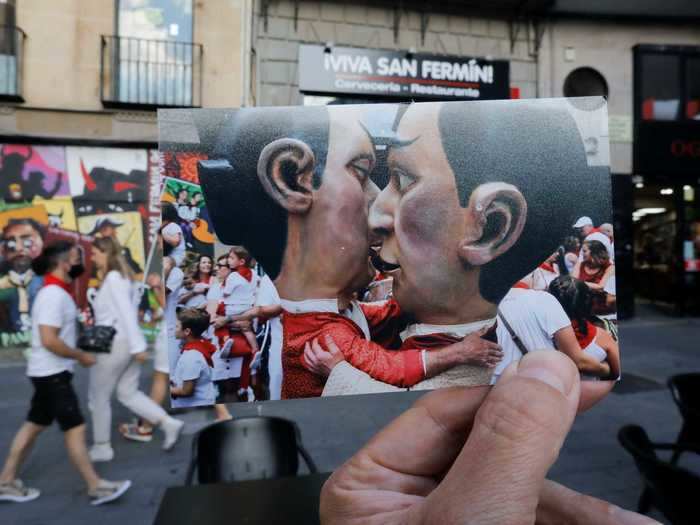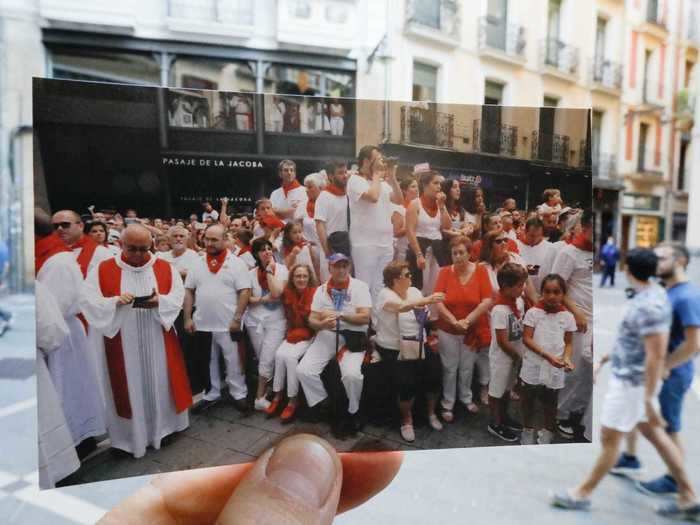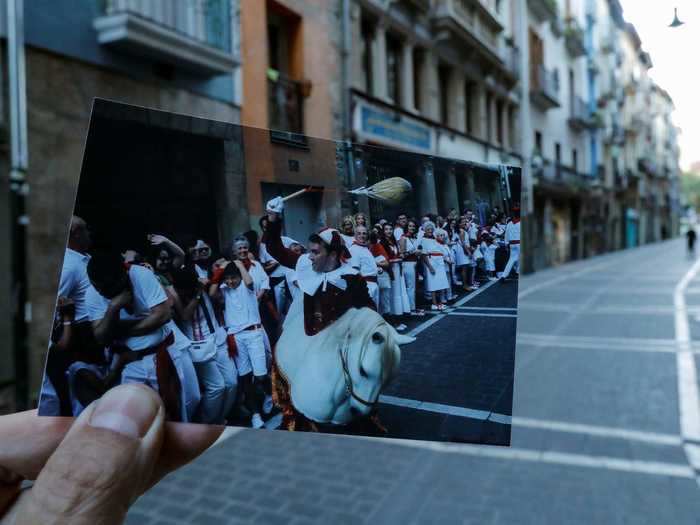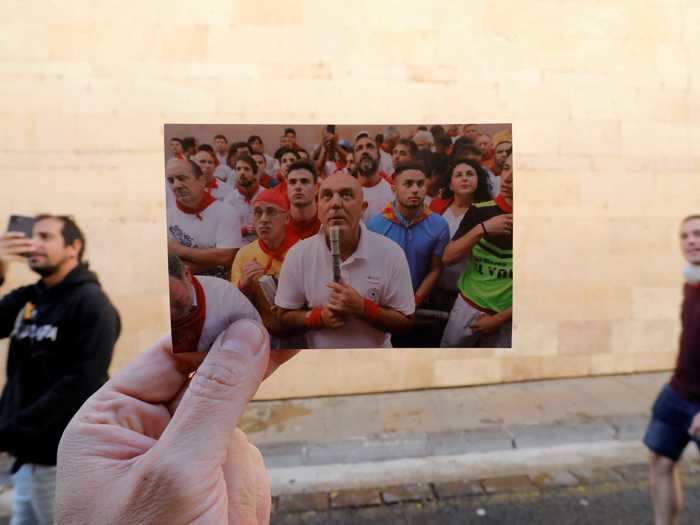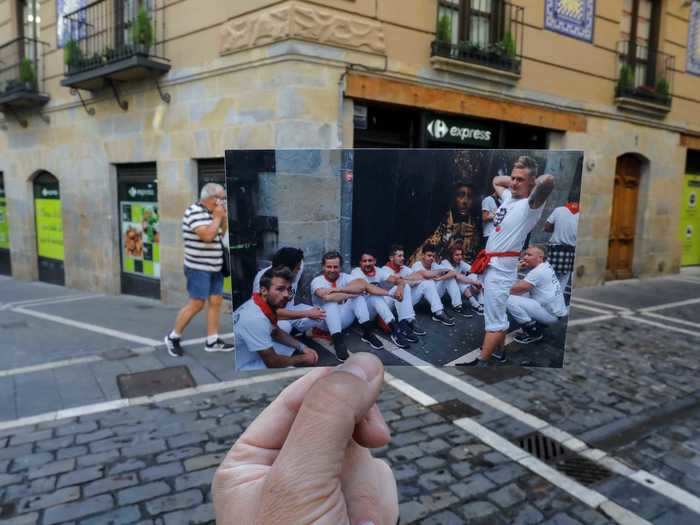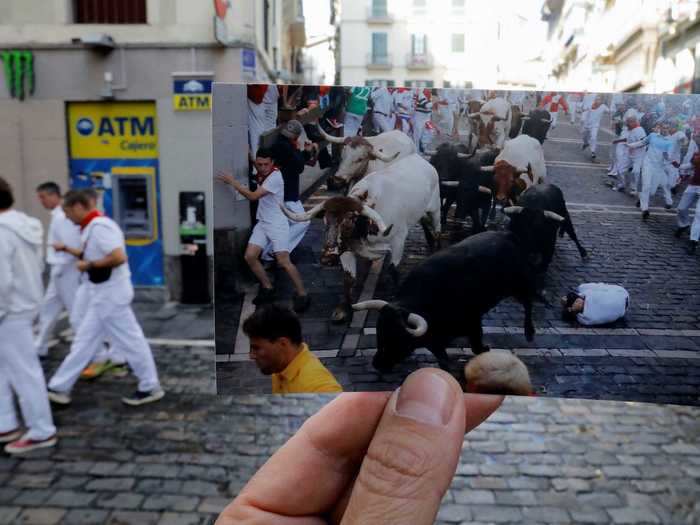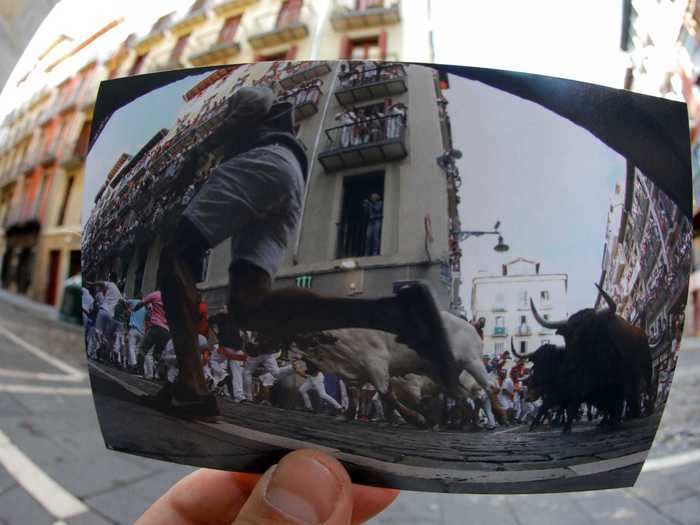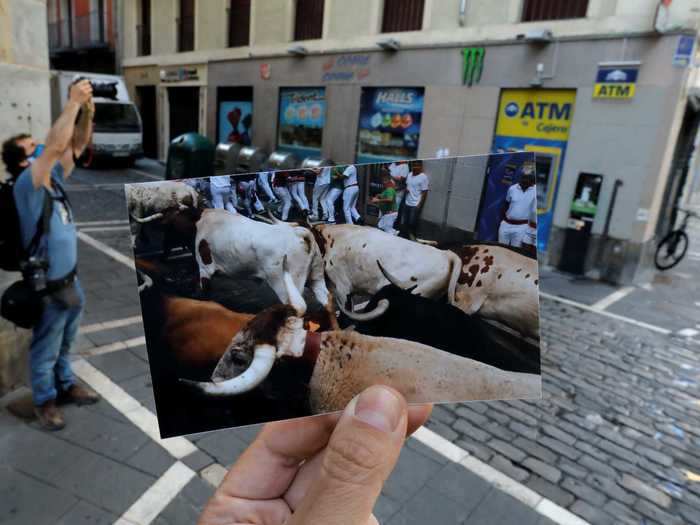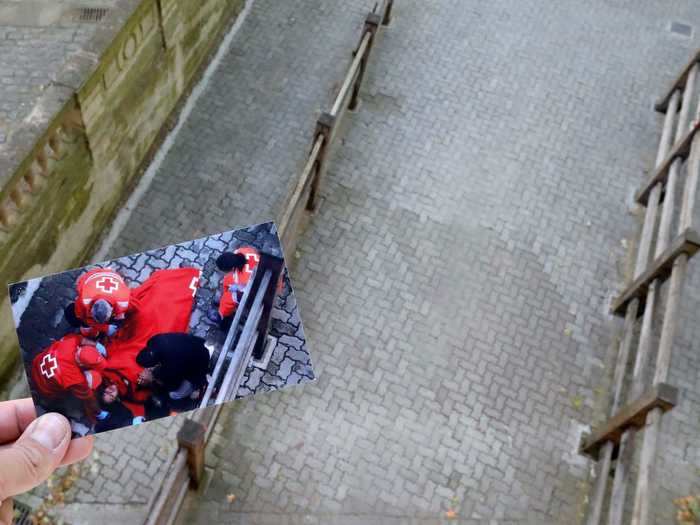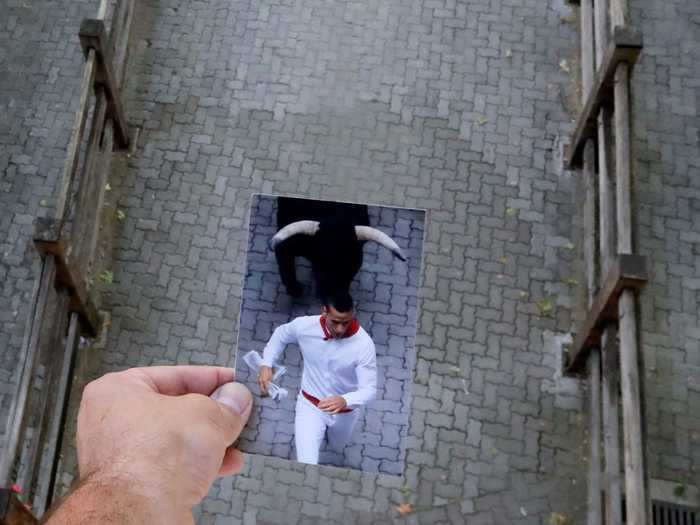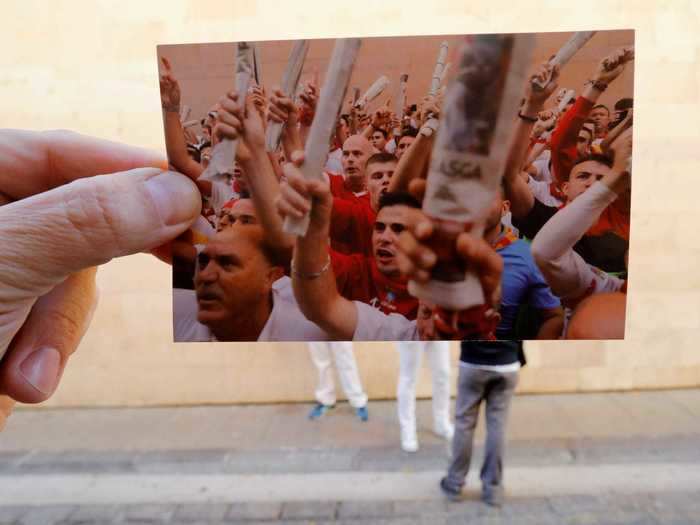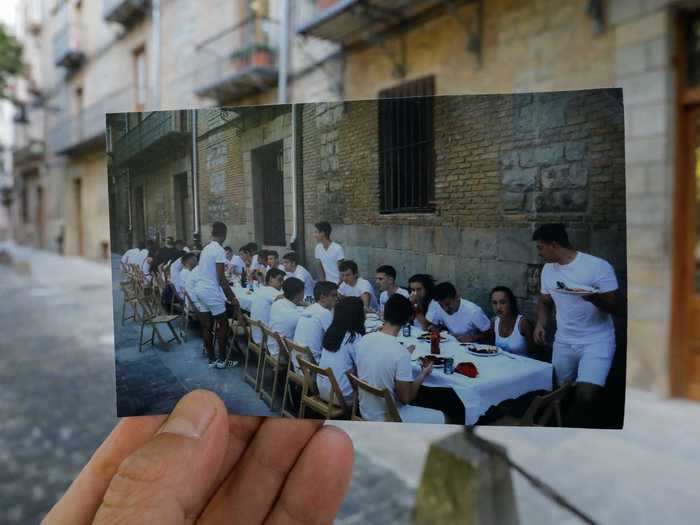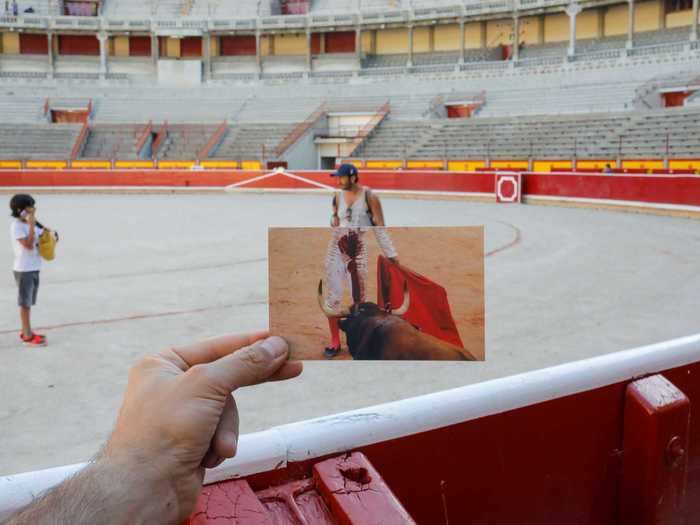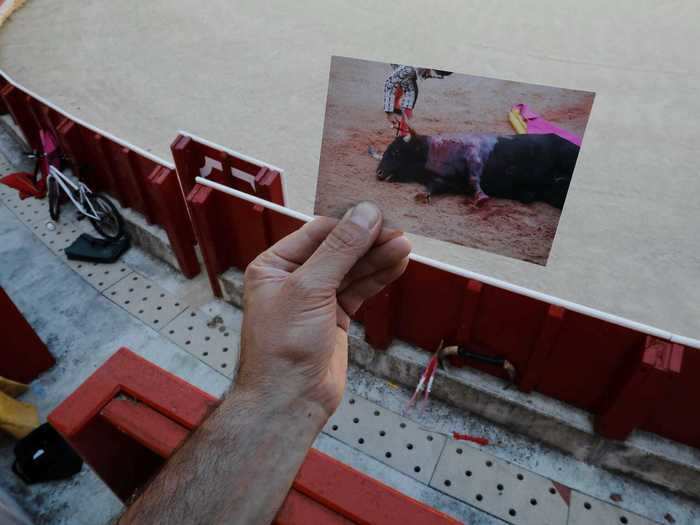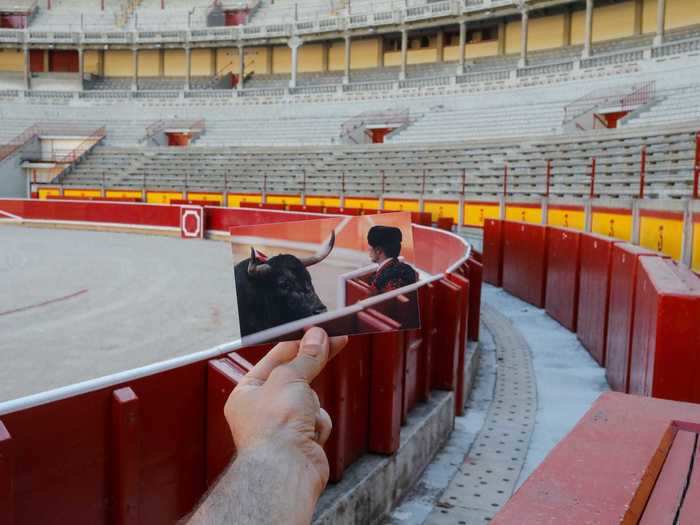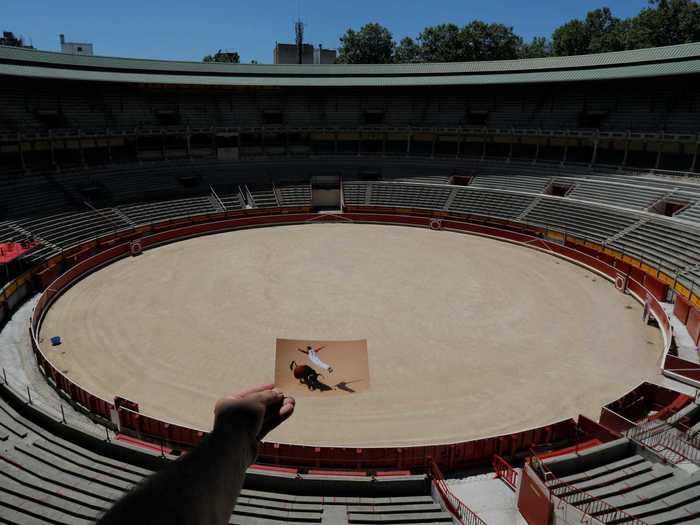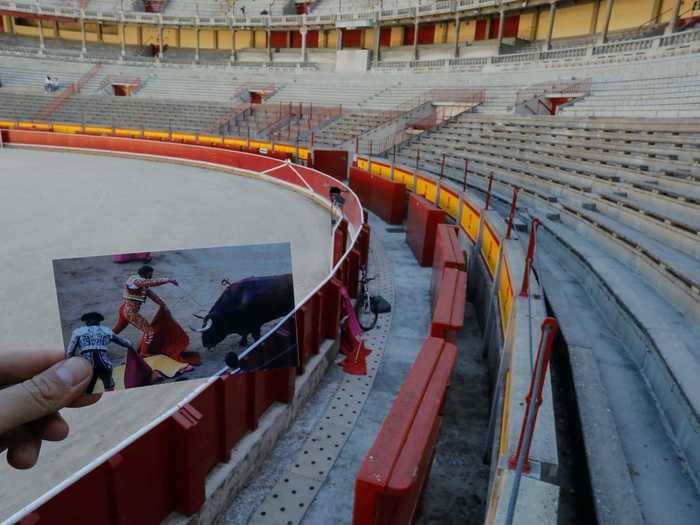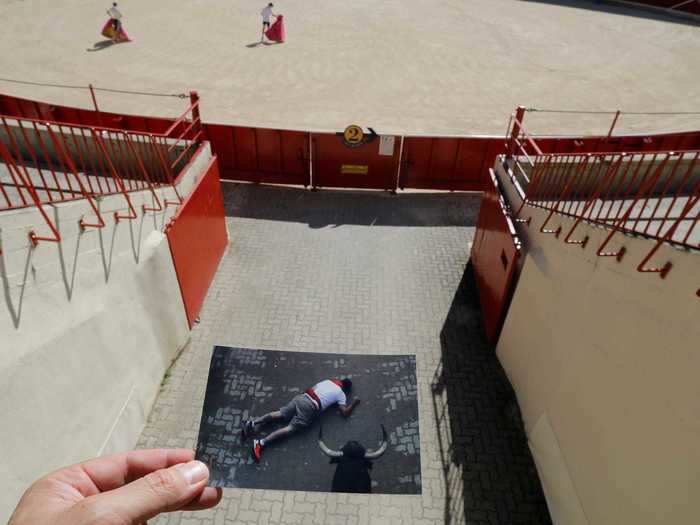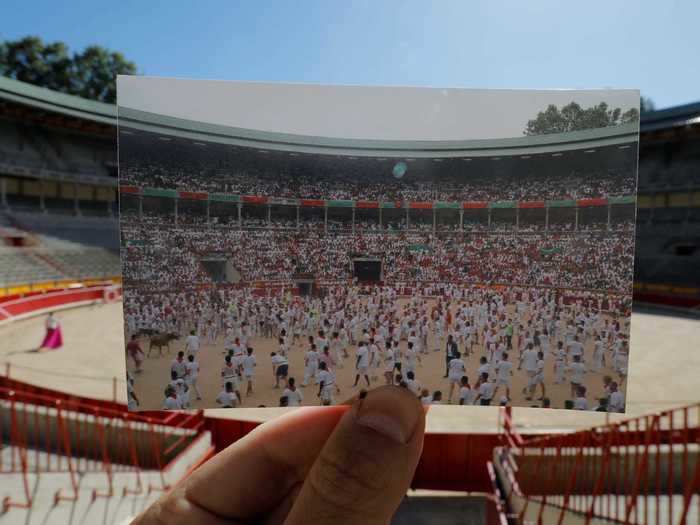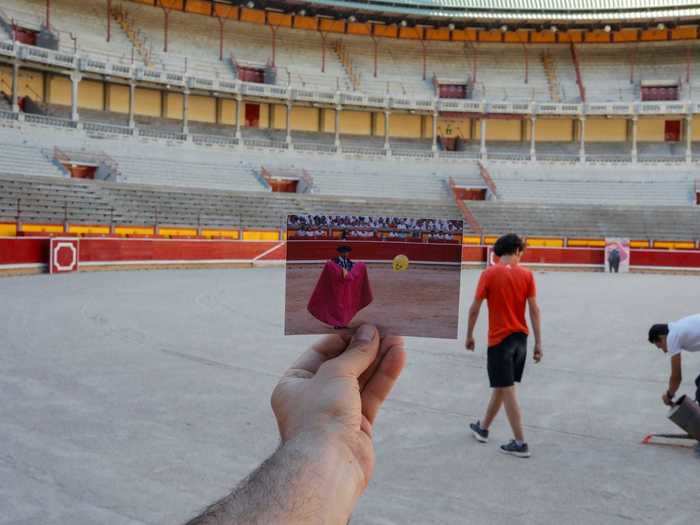A Reuters photographer holds a picture of revelers celebrating during the opening of 'chupinazo', taken in July 2019, in front of the square where the firing of 'chupinazo' took place.REUTERS/Jon Nazca/Illustration
- The annual San Fermin bull-running festival kicks off every year on July 6 in Pamplona Spain, and typically attracts 20,000 participants to run through the streets with bulls.
- But for the first time since the 1930s, the event was canceled due to the coronavirus.
- These photos, taken by Reuters photographer Jon Nazca, show what this year's empty streets and arenas look like compared to the typically bustling festivities.
For eight days of the year, the cobbled streets of Pamplona, Spain, become a raucous frenzy of drinking, dancing, and running from bulls.
The annual San Fermin bull-running festival has been referred to as the "super bowl" of bull runs, and typically takes place every year between July 6 and 15.
But for the first time in nearly a century, the event has been canceled due to the coronavirus.
In pre-pandemic times, hundreds of thousands of people flock to the streets or their balconies to watch up to 20,000 participants run through winding roads in order to escape the wrath of six bulls each morning.
After a race that stretches over 2,000 feet, the bulls are brought to a fighting ring where they face off against professional matadors.
The event involves several parades, celebrations to honor Saint Fermin, and a copious amount of celebratory drinking.
To highlight what the festival would typically look like, Reuters photographer Jon Nazca held up photos from last years festival in their usual locations to show how the pandemic has changed things.
Every year, hundreds of thousands of people gather in the streets to drink, dance, and watch participants run with the bulls from Jul 6 to 15.
A Reuters photographer holds a picture of revelers celebrating during the opening of 'chupinazo', taken in July 2019, in front of the square where the firing of 'chupinazo' took place, which opens the San Fermin festival.
REUTERS/Jon Nazca/Illustration
The San Fermin bull festival has become a cultural staple of Pamplona, Spain, and typically attracts up to 20,000 running participants.
A Reuters photographer holds a picture of revelers running next to the Fire Bull, a man carrying a bull figure packed with fireworks, during the opening of the San Fermin festival, taken in July 2019.
REUTERS/Jon Nazca/Illustration
But for the first time since the Spanish Civil War, the festival has been canceled because of the coronavirus.
A Reuters photographer holds a picture of a reveler watching bulls and steers inside a corral a day before of the first running of the bulls of the San Fermin festival.
REUTERS/Jon Nazca/Illustration
To commemorate the event, Reuters photographer Jon Nazca held up past photographs in their locations to show what the festival would typically look like. Here, a man is seen drinking wine from a large bottle before the opening ceremony.
A Reuters photographer holds a picture of a man drinking wine from a bottle before the firing of 'chupinazo.'
REUTERS/Jon Nazca/Illustration
The festival begins with the firing of a rocket called a "chupinazo," which signifies the start of the eight-day-long celebration.
A Reuters photographer holds a picture of a couple kissing each other during the opening of 'chupinazo.'
REUTERS/Jon Nazca/Illustration
During this event, crowds gather in front of the Pamplona Town Hall clad in red scarves to celebrate the start of the festival with bottles of champagne, and a roar of song and dance.
A Reuters photographer holds a picture of revelers holding up traditional red scarves.
REUTERS/Jon Nazca/Illustration
This photo shows a band of musicians playing at last year's opening ceremony.
A Reuters photographer holds a picture of a band playing during the opening of 'chupinazo', taken in July 2019.
REUTERS/Jon Nazca/Illustration
During the ceremony, people bring 'fire bulls' or bull s-aped figures stuffed with fireworks.
A Reuters photographer holds a picture of revelers watching Fire Bulls.
REUTERS/Jon Nazca/Illustration
A number of parades take place throughout the festival, too. This photo shows people taking part in the "Procession of Giants and Big Heads," which is a march of 25 massive paper-mâché figures that dance through the street each morning.
A Reuters photographer holds a picture of revelers taking part in the parade of "Comparsa de gigantes y cabezudos" (Giants and Big Heads) at the San Fermin festival, taken in July 2019.
REUTERS/Jon Nazca/Illustration
Here, two Cabezudos, or "Big Heads" are seen kissing during the procession.
A Reuters photographer holds a picture of "Cabezudos" embracing each other during the parade of "Comparsa de gigantes y cabezudos" (Giants and Big Heads) at the San Fermin festival.
REUTERS/Jon Nazca/Illustration
An additional parade to honor the Catholic Saint and the festival's namesake, St. Fermin, takes place each day.
A Reuters photographer holds a picture of revelers watching a procession on the Saints Day.
REUTERS/Jon Nazca/Illustration
During this procession, "Zaldikos," or men wearing horse costumes, join in on the festivities.
A Reuters photographer holds a picture of a "Zaldiko" hitting revelers with a sponge as he takes part in the procession of the Saints Day.
REUTERS/Jon Nazca/Illustration
Then, on the second day of the festival, the first "encierro," or run, takes place.
A Reuters photographer holds a picture of runners gathering before the running.
REUTERS/Jon Nazca/Illustration
The running of the bulls originated in the 14th century, as a way to transport the animals from fields to the Town Square to sell. In 1926, the tradition was made popular by Ernest Hemingway's novel "The Sun Also Rises."
A Reuters photographer holds a picture of runners waiting before the running of the bulls at the San Fermin festival, taken in July 2019.
REUTERS/Jon Nazca/Illustration
Typically, runs take place every morning starting at 8 a.m. To kick off the run, six bulls are released from the edge of Old Town and race through crowds of participants, composed of up to 20,000 people.
A Reuters photographer holds a picture of revelers sprinting near bulls and steers during the running of the bulls at the San Fermin festival.
REUTERS/Jon Nazca/Illustration
Many running participants wear traditional all white outfits with a red scarf, and are referred to as "mozos."
A Reuters photographer holds a picture of revelers sprinting near bulls and steers during the running of the bulls at the San Fermin festival.
REUTERS/Jon Nazca/Illustration
The thrill-seeking run typically lasts about three minutes.
A Reuters photographer holds a picture of revelers sprinting in front of bulls and steers during the second running of the bulls.
REUTERS/Jon Nazca/Illustration
The course runs 2,706 feet through winding Pamplona streets from a holding area to the bull ring.
A Reuters photographer holds a picture of revelers sprinting near bulls and steers during the second running of the bulls at the San Fermin festival, taken in July 2019.
REUTERS/Jon Nazca/Illustration
The event can be quite dangerous, and hospitalizations are a yearly tradition. Last year, two Americans and one Spaniard were stabbed by bull horns, and at least 16 people have been killed since records began being kept in 1910.
A Reuters photographer holds a picture of a reveler being helped by medical staff during the running of the bulls at the San Fermin festival.
REUTERS/Jon Nazca/Illustration
This photo shows a first-time participant sprinting quickly away as a bull trails behind him.
A Reuters photographer holds a picture of a reveler sprinting in front of a bull.
REUTERS/Jon Nazca/Illustration
Before the run takes place, participants can be seen singing a traditional song together.
A Reuters photographer holds a picture of runners participating in the traditional singing before the running of the bulls.
REUTERS/Jon Nazca/Illustration
And some participants share breakfast.
A Reuters photographer holds a picture of revelers having breakfast at the San Fermin festival.
REUTERS/Jon Nazca/Illustration
After the run, when participants reach the bull ring, a professional bullfighter, or matador, takes over to fight and kill the animal.
A Reuters photographer holds a picture of Mexican bullfighter Luis David facing a bull during a bullfight at the San Fermin festival, in front of the bullring, as tourists walk on the arena during the second day of San Fermin festival.
REUTERS/Jon Nazca/Illustration
This photo shows an empty arena behind a slain bull from last year's festival. The bull-running festival has sometimes been condemned by both Spaniards and foreigners who view the process as cruel to animals and toxic for humans.
A Reuters photographer holds a picture of an assistant bullfighter removing a sword after Spanish bullfighter Cayetano Rivera drove it into a bull during a bullfight at the San Fermin festival.
REUTERS/Jon Nazca/Illustration
During the fight, bullfighting assistants work to lure in the bull before the matador lurches at it with a sword.
A Reuters photographer holds a picture of an assistant bullfighter trying to draw the attention of a bull during a bullfight at the San Fermin festival.
REUTERS/Jon Nazca/Illustration
Typically, the arena is packed full of people anxiously awaiting the results of the fight.
A Reuters photographer holds a picture of a recortador jumping over a bull during a contest at the San Fermin festival, taken in July 2019.
REUTERS/Jon Nazca/Illustration
Here, a photograph of the Spanish bullfighter Antonio Ferrera shows the final moments of his sword striking a bull.
A Reuters photographer holds a picture of Spanish bullfighter Antonio Ferrera giving the 'coup de grace' with a dagger to a bull after driving the sword into it during a bullfight at the San Fermin festival.
REUTERS/Jon Nazca/Illustration
But the matador doesn't always have such an easy time. This photo from last year's festival shows a bullfighter being tackled to the ground by the animal.
A Reuters photographer holds a picture of Spanish bullfighter Javier Marin being tackled by a bull during a bullfight.
REUTERS/Jon Nazca/Illustration
And here, a man is seen on the ground at the entrance of the ring as a bull comes running out.
A Reuters photographer holds a picture of a reveler falling at the entrance of the bullring during the running of the bulls.
REUTERS/Jon Nazca/Illustration
After the bulls are removed from the ring, an additional festivity involving fighting cows begins. The cows are smaller than the bulls and, one by one, are released into the ring and fighters join in and attempt to dodge them.
A Reuters photographer holds a picture of revelers attempting to dodge a wild cow following the first running of the bulls at the San Fermin festival.
REUTERS/Jon Nazca/Illustration
This was the first time in four decades that the traditional festival didn't take place. Locals expressed sadness over the cancellation of the bull run, with one man telling NBC News that he felt "desolated."
A Reuters photographer holds a picture of an assistant bullfighter watching a balloon during a bullfight at the San Fermin festival.
REUTERS/Jon Nazca/Illustration
Though no live runs will take place this year, the state broadcaster TVE will play footage from previous runs each morning, and a mass for Saint Fermin will be held.
A Reuters photographer holds a picture of Spanish bullfighter Pablo Aguado driving the sword into a bull during a bullfight at the San Fermin festival.
REUTERS/Jon Nazca/Illustration

